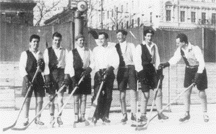After a two years’ interruption, in 1914 the tradition according to which the annual congress should be held at the venue of the European Championship, was resumed. On 25 February, the seventh federation congress brought along considerable turbulence and as many as three different presidents within a few hours.
To start with, Magnus, the president at the time of foundation, replaced the acting president van den Bulcke, but he resigned immediately because the delegates did not follow his programme. Vice president Patton then moved up as president and immediately called new elections with the result that van den Bulcke once again became president and Patton himself vice president.
Just a few months later, World War I hit also the sports world. During the war, there were no LIHG activities, neither at the sports field nor in the administrative area.
After World War I, the International Olympic Committee (IOC) expelled the "war losers" Germany and Austria from their ranks. The LIHG followed this decision in 1920, and at the same time, the membership of Bohemia was transferred to the newly established Czechoslovakia (TCH).
In 1920, Antwerp was the venue of the Olympic (Summer) Games. An ice hockey tournament was included in the Games and played from 23 to 29 April; for the first time, participants from beyond the seas, Canada and USA, joined in – although at the time the tournament started they had not yet been LIHG members – and demonstrated during the course of the tournament that the Europeans were no match for them.
At the LIHG congress which was held during that first Olympic ice hockey tournament, Canada and USA were admitted on 26 April 1920 as new members thus extending the federation beyond Europe. The LIHG leadership was totally replaced in Antwerp: Acting president was now the Swiss Max Sillig, who was at that time still actively playing, the two vice presidents were the Belgian. Paul Loicq and the American Frank Fellowes.
At the 1922 congress in St. Moritz, Loicq took Sillig’s place, and he was replaced as vice president by the Czech Dr. Karel Hartmann, as the second vice president, the American Haddock replaced his countryman Fellowes. In 1923 in Antwerp, the "foundation president" Magnus appeared again in the Council as vice president, and another one who was well known, the Briton Patton. At the congress in Antwerp the decision was also made to consider the 1924 Olympic tournament at the same time as world championship, and beside it, a separate European championship was scheduled for 1924. The new members admitted in the LIHG in 1923 were Romania, Spain, and Italy, and in 1924 the membership of the Austrians who were expelled in 1920 was renewed. The proposal by Sweden to also readmit Germany was however rejected, and consequently the Scandinavians left the federation, and only in 1926 – after Germany was readmitted – they returned to the circle of LIHG members. Sweden did not participate for some years due economical reasons (with the exception of the ice hockey tournament in conjunction with the 1928 Winter Olympic Games). The 1928 Olympic ice hockey tournament in St. Moritz was played at the same time also as a world and European championship, and there was a record participation of 11 teams.
During the second half of the 1920s – the congresses were held always at the venues of the international championships – the LIHG added the members Poland (1926), Hungary (1927) and Finland (1928).
In those years, Paul Loicq was always re-elected as president, but the vice presidents kept on changing: Peter Müller from Switzerland (1925– 1926 and again 1927–1928), William Hewitt from Canada (1925–1926 and again 1928– 1931) and his countryman Mulqueen (1926– 1928), the Austrian. Oskar Schlesinger (1926-1927), the Hungarian Karoly Csazar (1928–1929) and finally Marcout from France (1929– 1930).
In 1929, the congress decided in Budapest to organize from 1930 world championships every year, whereby the best placed team from Europe should win the title of European champion.
WCh Première.
This first world championship – apart from the Olympic ice hockey tournaments which were considered as world championships afterwards – was only partially successful from the point of view of the organization: Once the natural ice melted in the championship venue Chamonix, the last and decisive matches had to be moved to the Sports Palace in Berlin and to Vienna. After Japan joined the LIHG in 1930 as the first Asian association they immediately participated in the first world championship with a team composed of medical students. As expected, Canada emerged victorious as world champion.
The 1932 Olympic tournament in Lake Placid – due to the fact that most of the European associations could not raise the funds for the high costs because of the worldwide economic crisis – had to be satisfied with four participants only. The European championship, was played in the same year for the last time as a separate event, and had as many as nine teams taking part. The world championship 1933 in Prague brought Czechoslovakia the first artificial ice rink and the hockey world a sporting sensation: the Canadians, always confident of victory, were dethroned by their neighbours, the United States of America, and beaten into second place. The congress in Prague 1933 reviewed the first 25 years since the LIHG was founded: during that time, 18 European championships, 6 world championships and 4 Olympic ice hockey tournaments had been organized, including 20 congresses bringing along decisions which paved the way.









